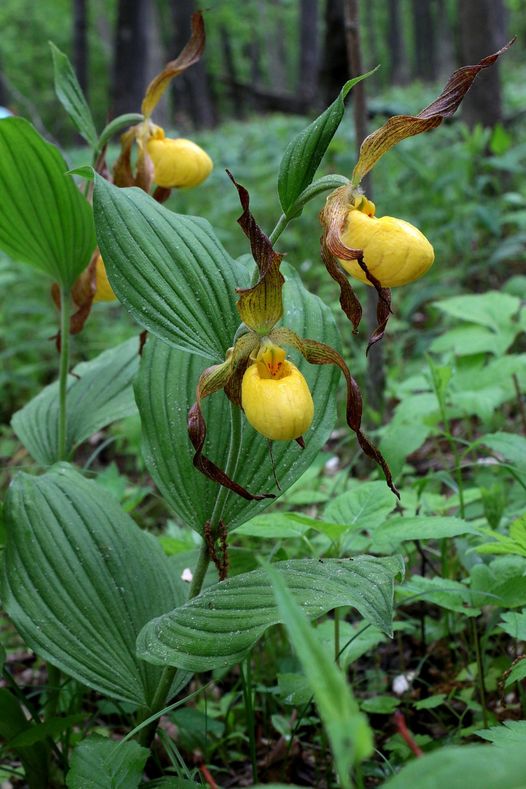
free genealogy since 1996
Allen County, Indiana Genealogy
Wildlife of Allen County, Indiana
Orchids
Most Allen County orchids have been lost to development. A few are known to exist in nature preserves which do NOT publicize the locations of orchids to prevent poaching of these habitat endangered plants to plant collectors. They require exact growing conditions and rarely survive transplanting. Specialized orchid nurseries can grow native orchids from seed which is a slow process often requiring several years and exact growing conditions. As the showy lady slipper orchid post shows they can live for decades perhaps 100s of years in impressive clumps in the proper habitat.
- Dactylorhiza viridis long-bract green orchid SE G5 S1 and Platanthera psycodes small purple-fringe orchid are the only orchids listed on the March 25, 2024 Indiana County Endangered, Threatened and Rare Species List County: Allen at the Indiana Department of Natural Resources.
- Indiana's Lady's Slipperson the Get Your Botany On! blog July 23, 2011.
- As Lady's-slippers in a spring forest on the Ohio Birds and Biodiversity blog points out orchids removed from the wild rarely survive and collectors often decimate the remaining populations which rarely recover previous population numbers.
- Plant of the Week Pink Lady's Slipper (Cypripedium acaule Ait.) by Patricia J. Ruta McGhan at USDA U. S. Forest Service
April 14, 2021 post by the Indiana Department of Natural Resources on Facebook:
WILDFLOWERS: YELLOW LADY'S SLIPPER: One of the tallest and most beautiful orchids in Indiana, the yellow lady’s slipper may stand 30 inches above the forest floor. There are over 40 native species of orchid in Indiana, some small and unrecognizable, others very showy. While uncommon and declining, the yellow lady’s slipper may be encountered in mid-May along a DNR forest trail. It is distributed widely in our state. Factors behind its decline are loss of habitat, invasive species, and being illegally picked or collected from its protected home on nature preserves, state forests and parks. The large inflated lower flower part gives it its name. It is pollinated by larger bees, who receive no nectar or pollen as a reward for their efforts. For information about Indiana's nature preserves, see dnr.IN.gov/nature-preserves. Photo by Brittany Davis.
WILDFLOWERS OF THE INDIANA DUNES NATIONAL PARK is an accessible field guide that bypasses the dry nature of many...
Posted by Indiana University Press on Thursday, May 5, 2022Thursday, May 5, 2022 post by Indiana University Press on Facebook:
WILDFLOWERS OF THE INDIANA DUNES NATIONAL PARK is an accessible field guide that bypasses the dry nature of many wildflower guides. In addition to the usual scientific species names, descriptions, and bloom periods, Nathanael Pilla and Scott Namestnik offer deeper narratives—folklore surrounding the flowers, look-alikes, animals associated with the plants—that will be remembered much more easily than the length of a petal.
Available now!
Wildflowers of the Indiana Dunes National Park****************
The cover photo shows wild lupine and pink lady slipper orchids with special habitat requirements not known if ever found growing in Allen County.
Wild Lupine, but no orchids, are on the Fort Wayne Plant List posted by City of Fort Wayne. There is an interesting discussion January 18, 2024 about planting the
wrongspecies of native lupines and the federally endangered Karner Blue Butterfly whose only larval host is Sundial Lupine a subspecies Lupinus perennis subsp. perennis on the Indiana Native Plant Society (INPS) group Facebook page.******************
The lupine are dressing up the landscape at Badger Barrens a little earlier than normal! We anticipate the peak to be...
Posted by Blue Heron Ministries, A Land Trust on Tuesday, May 7, 2024Tuesday, May 7, 2024 post by Blue Heron Ministries, A Land Trust on Facebook:
The lupine are dressing up the landscape at Badger Barrens a little earlier than normal! We anticipate the peak to be towards the end of this week. Hopefully, the weather will provide you with a opportunity to come hike the trail and soak it in.
Small plot of Steuben County comes alive with color this spring The News Sun
Badger Barrens, a 13-acre nature preserve in Steuben County is covered in a coat of blue, white, and purple lupines. The foot-tall plants are native to Steuben, LaGrange, and Elkhart counties and established with collected seeds in 2008. Lupines were still plentiful in the sandy soils in the 1930s and 1940s. Blue Heron Ministries is a Steuben County based environmental ministry of the Presbyterian Chapel of the Lake Church. Its ongoing mission is “to preserve creation and restore the land to its natural, native ecology through good and focused environmental stewardship.” www.blueheronministries.org .
National Wildflower Week- Thursday Throwback We're celebrating National Wildflower Week by sharing the most popular...
Posted by Ohio Division of Natural Areas and Preserves on Thursday, May 9, 2024Thursday, May 9, 2024 post by the Ohio Division of Natural Areas and Preserves on Facebook:
National Wildflower Week- Thursday Throwback
We're celebrating National Wildflower Week by sharing the most popular post from April is Ohio Native Plant Month! The winner was our April 16 post on one of Ohio’s prettiest native orchids—pink lady’s slipper (Cypripedium acaule). Also called moccasin flower, this orchid is easily identified by its bubblegum pink inflated pouch or “slipper" along with its two hairy, strongly veined basal leaves. One of the most exciting (and rare) sights is finding a white flower growing among all the pink ones!
One of five different Cypripediums native to Ohio, pink lady’s slipper is our most common. It occurs throughout south and east Ohio in dry upland forests of pines and/or oaks. It loves acidic, sandy, well-drained soils and can form large colonies of hundreds of plants! Although not rare, it’s not commonly found either, so it’s a real treat to find pink lady's slipper blooming.
*********************
Pink Lady's Slipper grows in acidic soils, whether they be in bogs or in dry conifer and oak woodlands. Copied from Indiana's Lady's Slippers on the Get Your Botany On! blog July 23, 2011.
Continuing the celebration of April’s Native Plant Month is an Ohio wildflower unequalled in its beauty. The showy...
Posted by Ohio Division of Natural Areas and Preserves on Tuesday, April 18, 2023Tuesday, April 18, 2023 post by the Ohio Division of Natural Areas and Preserves on Facebook:
Continuing the celebration of April’s Native Plant Month is an Ohio wildflower unequalled in its beauty. The showy lady’s slipper (Cypripedium reginae) is the largest of Ohio’s 50 native orchids and when in full bloom, they create an unforgettable scene of natural beauty.
A state-threatened species, the showy lady’s slipper buds in May and flowers through June, making it the last of Ohio’s spring wildflowers to appear. With habitat loss and poaching challenges, it’s not an easy wildflower to find. The best public viewing spot for this gorgeous pink and white flowered orchid is at Cedar Bog State Nature Preserve in Champaign County. It’s a must-see spot to visit in early June to see witness their gorgeous blooms from a boardwalk trail.
The showy lady’s slipper is a finicky plant and prefers a specific high-quality wetland habitat such as boreal and cedar fens. They require consistent moisture and sun; if the conditions aren’t right, the plants will quickly disappear. If the conditions are right, individual plants can live to be 20, 30, 40 years and older. Some of Ohio’s larger impressive clumps are estimated to be hundreds of years old.
Also called queen lady’s slippers, this beautiful orchid is pollinated by flies, beetles, and bees.
Check back tomorrow for another wildflower species profile. Throughout April, we will be introducing many of our favorite spring, summer, and even fall wildflowers as we continue our celebration of Ohio’s Native Plant Month!
Did you know today is National 🥀Orchid Day? Today we're celebrateing April is Ohio Native Plant Month and National...
Posted by Ohio Division of Natural Areas and Preserves on Tuesday, April 16, 2024Tuesday, April 16, 2024 post by the Ohio Division of Natural Areas and Preserves on Facebook:
Did you know today is National
Orchid Day?
Today we're celebrateing April is Ohio Native Plant Month and National Orchid Day! May we present one of Ohio’s prettiest native orchids—pink lady’s slipper (Cypripedium acaule). Also called moccasin flower, this orchid is easily identified by its bubblegum pink inflated pouch or “slipper" along with its two hairy, strongly veined basal leaves.
One of the most exciting (and rare) sights is finding a white flower growing among all the pink ones! One of five different Cypripediums native to Ohio, pink lady’s slipper is our most common. It occurs throughout south and east Ohio in dry upland forests of pines and/or oaks. It loves acidic, sandy, well-drained soils and can form large colonies of hundreds of plants! Although not rare, it’s not commonly found either, so it’s a real treat to find pink lady's slipper blooming.
Bumblebees are its primary pollinator. The sweet aroma of the slipper and its bright blooms draw
inside the slipper. Upon entering, the
find themselves trapped without reward; the only way out is a narrow opening at the top that takes them past the pollen mass. As they squeeze through,
will deposit pollen on the stigma for pollination! Look closely and you may see slippers with holes which are left behind by bumblebees that chewed their way out!
In honor of National Orchid Day, here are some of our favorites at Mt. Cuba Center! 1. Kentucky lady's slipper...
Posted by Mt. Cuba Center on Tuesday, April 16, 2024Tuesday, April 16, 2024 post by Mt. Cuba Center on Facebook:
In honor of National Orchid Day, here are some of our favorites at Mt. Cuba Center!
1. Kentucky lady's slipper (Cypripedium kentuckiense)
2. Lesser yellow lady's slipper (Cypripedium parviflorum)
3. Grass pink (Calopogon tuberosus)
4. Chadds Ford Atlantic ladies'-tresses (Spiranthes bightensis 'Chadds Ford')
